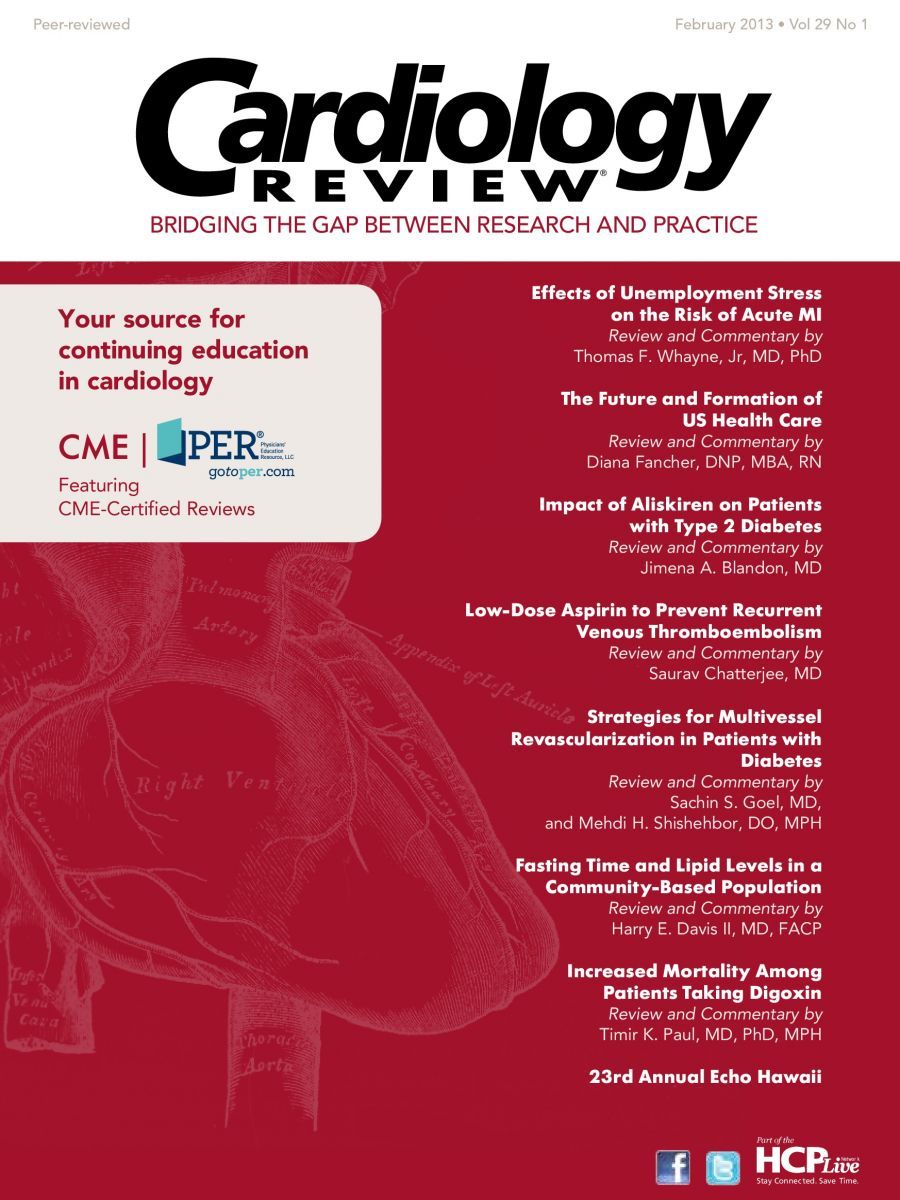A New Year of Cardiology Review
Debabrata Mukherjee, MD, MS, FACC
Editor-in-Chief
As winter loosens its grip on the country, I hope most of us are ready to shake off the blues and enjoy spring. In line with the season for rejuvenation, renewal, resurrection, and regrowth, this particular issue of Cardiology Review discusses many important articles and viewpoints that I hope will rejuvenate our minds.
Dr. Saurav Chatterjee discusses low-dose aspirin to prevent recurrent venous thromboembolism (VTE) and opines that the ASPIRE study substantiates earlier evidence of a possible therapeutic benefit of aspirin when given to patients after initial anticoagulant therapy for a first episode of unprovoked VTE. Dr. Harry Davis reviews the evidence for fasting time and lipid levels in a community-based population and suggests that because many patients are in the habit of obtaining fasting lab tests prior to a scheduled visit, this is probably a reasonable habit to continue. But if the patient is seen first, the random collection of the lipid profile may be justified based on this study.
Drs. Sachin Goel and Mehdi Shishebhor look at strategies for multivessel revascularization in patients with diabetes and suggest that further research should help identify those patients with diabetes and multivessel coronary disease who will benefit from percutaneous coronary intervention; however, until then, coronary artery bypass graft appears to be superior in the majority of these individuals. Dr. Thomas Whayne comments on social challenges and the effects of unemployment stress on the risk of acute myocardial infarction and points out that for most workers, unemployment represents a major life stress. Such stress in and of itself could lead to post-traumatic stress disorder and has well-established mechanisms associated with acute cardiovascular (CV) events. He thinks that these findings impose on employment counselors and physicians the reality of added CV risk and emphasize the importance of maximizing the prevention of psychosocial and traditional CV risk factors.
Dr. Jimena Blandon, our budding nephrologist, discusses the impact of aliskiren on patients with Type 2 diabetes and notes that until more data are gathered about adding aliskiren to angiotensin-converting enzyme inhibitors or angiotensin receptor blocker therapies, we should follow current recommendations regarding renin-angiotensin-aldosterone system inhibition to add years of life to our diabetic patients and their kidneys. Dr. Timor Paul, one of our new board members, examines the increased mortality seen among patients taking digoxin, and suggests that low-dose, close monitoring of digoxin level and clinical symptoms is key and he would not necessarily eliminate the use of digoxin in this population— particularly in cases of low serum digoxin levels.
Dr. Diana Fancher comments on the future and formation of the US Affordable Care Act (ACA)—Obamacare—and reminds us that although 2 major obstacles to the implementation of the ACA have been cleared, powerful threats to its full realization remain in the future. Deep spending cuts and increased taxes being considered by Congress would certainly have an impact on the implementation of the ACA.
In this issue we introduce a new section, Clinical Forum, in which clinicians discuss a question about a hot topic. For our inaugural section, Drs. Tracy Macaulay, Rabab Mohsin, and Karla Quevedo opine on statins and the risk for diabetes, and whether such a concern should impact therapy. Please enjoy the lively conversation on this topic.
Finally, the insightful compilation of studies presented at the American Society of Echocardiography’s 23rd Annual Echo Hawaii conference, held January 21-25, 2013, at Kohala Coast, Big Island, HI, by our excellent managing editor, Ms. Jackie Syrop, should keep you updated on the latest happenings in the imaging field. She discusses several key items in the news, namely the impact of epicardial adipose tissue, utility of pocket ultrasound, and prognostic value of left atrial volume index change, among others.
I hope that you will find these commentaries to be valuable and enjoyable. I encourage you to share your insights, thoughts, and personal experiences on the topics touched upon in this issue. On a broader level, I would love to hear feedback on how we can make this journal even better. My goal continues to be to make you look forward to every issue of Cardiology Review.
Debabrata Mukherjee
Editor-in-Chief
